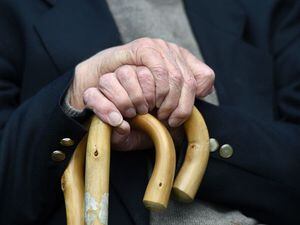Care home resident deaths a fifth higher than average during pandemic – ONS
Some 173,974 deaths of care home residents were registered in England and Wales between March 14 and April 2, the Office for National Statistics said.

The number of care home residents who died during the coronavirus pandemic in England and Wales was a fifth higher than the average for the previous five years, figures show.
Some 173,974 deaths of care home residents were registered in England and Wales between March 14 2020 and April 2 2021, the Office for National Statistics (ONS) said.
This is a rise of 19.5% compared to the average for that period recorded over the previous five years – 145,560 deaths.
Coronavirus accounted for 42,341 care home resident deaths – almost a quarter (24.3%) of the total.
The figures cover deaths of care home residents in all settings, not just in care homes.
Overall deaths fell between waves one and two, with 89,528 deaths in the first wave, which the ONS defines as deaths registered up to September 12 2020.
From this point on, during the second wave, 84,446 deaths were registered.
There were 27,079 excess deaths in the first wave of the pandemic, and 1,335 excess deaths during the second wave.
The ONS said this may be due to delayed access to care services, rapid testing and personal protective equipment (PPE) during wave one.
In the second wave, care home occupancy was lower and residents were prioritised for a Covid-19 vaccine from December.
And some of those who may have died in the second wave may have died earlier, the ONS said.
At the first wave peak, total deaths were around 3.4 times higher than the five-year average, with deaths 1.3 times higher than usual at the peak of wave two.
The figures also show there was a higher proportion of deaths involving Covid-19 in wave two than in wave one.
Some 20,664 deaths of care home residents mentioned Covid-19 in wave one compared with 21,677 deaths (25.7%) in wave two.
The ONS advised caution when comparing the two waves, since there could have been undiagnosed coronavirus cases in the first wave due to less testing and less clinical experience with a new disease.
Throughout the pandemic, Covid-19 was the leading cause of death in male residents, while for female residents it was dementia and Alzheimer’s disease, followed by coronavirus.
Dementia and Alzheimer’s disease was the most common pre-existing condition among residents who died with Covid across both waves.
Kevin McConway, emeritus professor of applied statistics at the Open University, said: “ONS believe (and I agree) that an important reason there were more registered deaths involving Covid-19 in the second wave was simply that a lot of deaths that really involved Covid-19 in the first wave were not recorded as such, because there were many undiagnosed cases, because there was much less testing and health care workers had much less experience of the diseases back then.
“Those issues will make it difficult to understand the patterns in the data when we eventually come to an inquiry about the pandemic.”
Dan Scorer, head of policy at the learning disability charity Mencap, said: “The pandemic has caused so much devastation in care homes across the UK.
“Yet there has been little focus on the impact on working-aged disabled adults who live in care homes – including people with a learning disability. Their suffering has often been forgotten.
“The forthcoming independent inquiry into the handling of the pandemic must address the high death rate of people with a learning disability, and set out recommendations for urgent system change to address the shocking levels of premature death and health inequalities experienced by people with a learning disability.”





